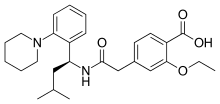Meglitinide
Meglitinides (glinides) make up a class of drugs used to treat diabetes type 2.[1]
They bind to an ATP-dependent K+ (KATP) channel on the cell membrane of pancreatic beta cells in a similar manner to sulfonylureas but have a weaker binding affinity and faster dissociation from the SUR1 binding site. This increases the concentration of intracellular potassium, which causes the electric potential over the membrane to become more positive. This depolarization opens voltage-gated Ca2+ channels. The rise in intracellular calcium leads to increased fusion of insulin granula in the cell membrane, and therefore increased secretion of (pro) insulin.
Drugs
Repaglinide (Prandin), gained FDA approval in 1997.
Other drugs in this class include nateglinide (Starlix) and mitiglinide (Glufast).
Side effects
Side effects include weight gain and hypoglycemia. While the potential for hypoglycemia is less than for those on sulfonylureas, it is still a serious potential side effect that can be life-threatening. Patients on this medication should know the signs and symptoms of hypoglycemia and appropriate management.
Repaglinide (Prandin) caused an increased incidence in male rats of benign adenomas (tumors) of the thyroid and liver.[2] No such effect was seen with another drug of this class, nateglinide (Starlix).[3]
References
- Blicklé JF (April 2006). "Meglitinide analogues: a review of clinical data focused on recent trials". Diabetes Metab. 32 (2): 113–20. doi:10.1016/S1262-3636(07)70257-4. PMID 16735959.
- Prandin (repaglinide) prescribing information, fda.gov
- Starlix (nateglinide) prescribing information, fda.gov
